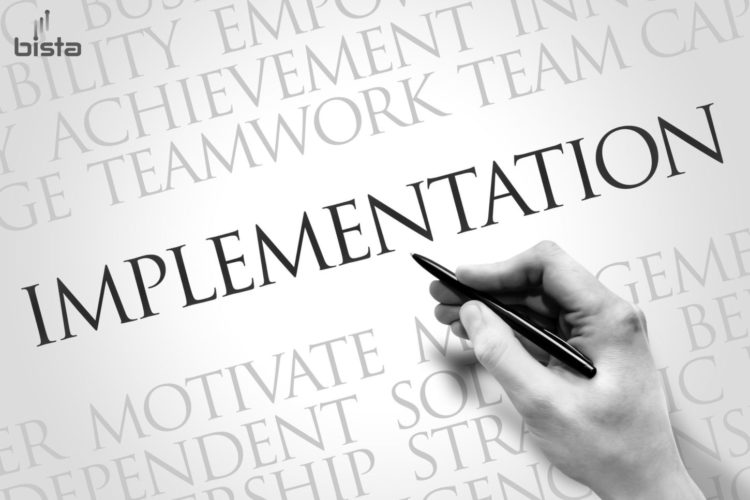ERP implementation projects can quickly become a nightmare without proper planning and management, making it crucial for organizations to take the process seriously and avoid common pitfalls. With over 30 years of experience in ERP implementation, we have gained deep expertise in the details of the implementation process. Our experience has taught us how to effectively lead ERP implementations to success and assist you in avoiding common pitfalls of ERP implementation failures. Here are some key factors you should know to confidently navigate the ERP implementation process.
1. Not Having a Clear Objective
Clear objectives serve as a road map for the implementation of the ERP project, guiding the selection of relevant ERP modules, defining project scope, allocating resources, and developing key performance indicators (KPIs) to track progress. When objectives aren’t clear, it is difficult to match the implementation process with the expected outcomes. It is impossible to prioritize work, allocate resources effectively, and track progress without defined objectives. As a result, the implementation will fail.
How to Define Clear Objectives?
- Determine the company’s main challenges.
- Involve stakeholders from all departments to understand their perspectives and expectations.
- Prioritize goals based on their impact and feasibility.
- Convert broad aims into concrete, quantifiable targets.
- Set KPIs that are aligned with each target.
- Ensure that everyone understands the objectives and their role in attaining them.
2. Poor Planning
Effective planning is crucial for successful ERP implementation. Inadequate or ineffective planning can give rise to various issues that hinder progress and result in delays, exceeding budgets, and failure to achieve desired results. It is essential to invest time and effort in comprehensive planning to mitigate risks and ensure a smooth and successful ERP deployment.
How to Plan Effectively?
Points to consider before planning for ERP implementation:
- Goals and objectives
- Critical business processes
- Requirements and functionalities
- Budget and timeline
- Risks and challenges
- Integration with existing systems
- Training and change management
- Data migration and quality
- Ongoing technical support
3. Lack of Committed Leadership
One crucial reason for ERP implementation failure is the absence of committed leadership due to which Businesses may face a lack of clear direction and vision, resulting in confusion and delays during the implementation process. By committed leadership we mean a person who closely aligns with the organization’s goals and clearly communicates their expectations for the ERP implementation. It is imperative for business owners to prioritize committed leadership that can drive the implementation forward, and ensure effective communication, ultimately leading to a successful ERP implementation.
How to Avoid This?
- Clearly define the responsibilities and roles of leadership.
- Choose a passionate leader who will be in charge of the implementation process.
- Make certain that the chosen leader is aware of the goals and objectives of the business.
- Encourage open dialogue and effective teamwork between the implementation team and organizational leaders.
- Give the selected leader the necessary instruction and encouragement to improve their knowledge and abilities.
- Encourage top-level management to be actively involved and engaged throughout the implementation.
- Establish explicit guidelines for leadership participation and responsibility throughout the implementation phase.
4. Choice of Implementation Partner
Choosing the right implementation partner is important to the success of any project, particularly complicated and technology-intensive ERP implementation. The implementation partner you choose should have the required skills, resources, and experience to finish the project on time, on budget, and with the intended quality. Otherwise, you would be unable to reap the full benefits of your ERP implementation.
How to Choose the Right Implementation Partner?
- Examine the experience, competence, and industry understanding of the partner.
- Assess the technical skills and capabilities of your partner.
- Request client testimonials and references.
- Recognize your partner’s project management technique.
- Inquire about post-implementation assistance and training options.
- Ensure congruence with corporate goals.
- Examine your collaboration and communication skills.
- Consider scalability and future growth potential.
5. Resistance to Change
In today’s business landscape, organizations often face substantial challenges when it comes to adapting to the changes brought about by implementing an ERP system. Despite the potential benefits, the efforts invested can become futile if the user resists the necessary changes and prefers to cling to familiar, traditional ways of doing things.
How to Implement Proper Change Management?
To address this issue effectively, it is crucial to foster inclusivity and ensure that comprehensive change management strategies are in place, encompassing procedural, technological, and human resource aspects. By engaging everyone and facilitating a smooth transition, organizations can overcome resistance to change and maximize the value derived from the ERP system.
6. Inadequate Testing
Insufficient or inadequate testing during ERP deployment can result in critical errors, system malfunctions, and inaccurate information, which can significantly impede the effective implementation and utilization of the ERP system. Comprehensive testing is necessary, encompassing single business activity tests, volume tests, and simulated go-live scenarios. Therefore, it is crucial to choose the right implementation partner with expertise in qualitative analysis to ensure smooth operations and minimize risks.
How to Test Effectively?
- Establish clear testing objectives aligned with business goals and expectations.
- Validate critical business processes supported by the ERP system.
- Perform end-to-end testing to ensure smooth integration and data flow.
- Validate data migration accuracy and completeness.
- Assess system scalability for handling increased volumes and growth.
- Involve end-users in user acceptance testing to validate functionality.
- Evaluate training materials and support mechanisms for effectiveness.
7. Communication Barriers
Inadequate communication between your company and the ERP implementation partner might lead to ERP failure. For starters, it might cause expectations to be misaligned, resulting in misunderstandings and delays in the implementation process. Second, your implementation partner will be skeptical about your organization’s needs, resulting in a system that does not satisfy your specific requirements. It also resulted in delayed issue resolution resulting in extended project timelines.
How to Communicate Effectively?
- Set up regular meetings to update and review project progress.
- Use collaborative tools and platforms.
- Define roles and duties for your organization as well as your ERP Implementation partner.
- Encourage open communication and feedback between parties.
- Maintain a consolidated collection of project-related documents.
- Keep everyone up to date on project progress, milestones, and modifications.
- Address complaints and concerns as soon as possible to avoid delays or complications.
8. Lack of User Training & Support
ERP implementations might suffer from poor training and support, which can also result in failure. Users can find it difficult to adapt to and fully utilize the ERP system if they are not properly trained on its features and processes, which will lead to inefficient and ineffective workflows.
How to Provide the Right User Training?
- Conduct comprehensive research on the training and support offerings of your chosen ERP implementation partner.
- Develop a tailored training plan that aligns with your organization’s specific needs. (Collaborate with Bista Solutions to leverage their 24/7 support and user training services)
- Conduct training sessions to familiarize users with the ERP features and workflows.
- Ensure access to post-implementation support.
- Request comprehensive user documentation and resources from your implementation partner. (Bista Solutions offers a vast library of resources and can provide customized documentation support specific to your implementation)
- Organize refresher sessions to reinforce knowledge and empower super-users.
9. Poor Data Quality
Having clear, accurate, and well-formatted data while implementing ERP software is very important. Ignoring poor-quality data puts the organization to risk and leads to ERP Implementation failure. Moving on with the implementation project without resolving data issues might result in greater operational expenses, lower team member performance, slower decision-making processes, and poor customer satisfaction.
How to Ensure Data Quality?
As a business owner consider the following points to ensure that Quality is not compromised-
- Establish data standards for precision, completeness, and consistency.
- Create a framework for data governance to manage data quality.
- Before migrating, thoroughly cleanse and validate the data.
- Create ongoing data maintenance processes.
- Users should be trained on data entry best practices.
- Use data analytics for continuous monitoring and problem detection.
10. Non-Realistic Timeframe
Unrealistic time frames in ERP implementation can arise from a desire for immediate results and a limited understanding of the complexity involved. Unfortunately, such situations often lead to notable challenges and potential failure. Setting unreasonably tight deadlines can burden the implementation team, compelling them to rush tasks or handle multiple aspects concurrently. Therefore undermining the overall success of the implementation process.
How to Avoid This?
- Conduct comprehensive project analysis and assessment
- Identify necessary tasks and resources
- Create a detailed project plan with clear timelines
- Incorporate contingency time for unforeseen issues
- Involve stakeholders and seek their input
- Monitor progress regularly
- Maintain open communication with the team and stakeholders
- Identify and address potential delays promptly.
Choose Bista Solutions Succesful ERP Implementation Services
- 3 Decades of ERP implementation Experience
- 200+ Successful Custom App developments
- 250+ Expert Developers at your service
- 350+ Successful Project Implementations Completed
- One of the Most Trusted Odoo Gold Partners
- Global Presence in 10+ Countries
Discuss your thoughts, concerns, and aspirations related to ERP implementation, and we’re here to guide you every step of the way. Schedule a free demo or Talk to our Expert Consultants Today!





